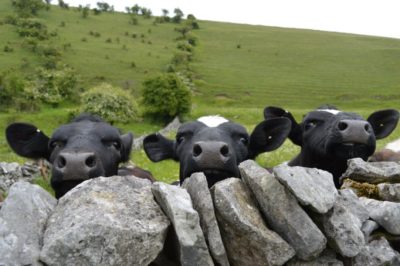I’m currently working with Simon, he’s just bought a rural Vet’s Practice five miles down the road from me in Conwy, acquiring the business from the founder who wants to retire after 35 years. I’m helping him with a growth plan, but I spent last Thursday with him to see what a day in the life of looked like to understand the business dynamics.
Straight away, I can see Simon has the number one entrepreneur’s attribute for success – a burning passion for what he does. He has passion for his clients (the animals), their owners (both farmers and pet owners), for his craft – he meticulously cares about what he does – and for the staff in the Practice.
We meet at 730am. Simon checks on overnight inpatients. Luckily, I didn’t get called out last night to any emergencies, but I did have a phone call at 3am so I definitely need a coffee he says with a smile. A pet rabbit with a painful abdomen has finally produced some droppings. She looks much brighter. Susie the labradoodle with pancreatitis was vomiting and dehydrated yesterday but looks much better after a night on a drip and medications. She even wags her tail.
Simon calls a couple of farmer clients with important lab results and plans on what to do next. Then he’s spaying a sixteen-month-old Golden Retriever called Honey, before two cat check-ups from the local rescue charity, and a dental on Rocky, a crazy ten-year-old Dalmatian. I really enjoy my small animal surgery sessions. It’s always rewarding to see the patients recovering from anaesthesia wrapped up in warm blankets and being monitored by the nursing team until they’ve come around.
Before going out on his rounds, he spends time reviewing Monty’s case, a sixteen-year-old cat. He calls Monty’s owner with an update. Sadly, Monty’s kidneys look to be failing and his thyroid hormone levels are high, and he has dental disease. Each of these conditions on their own are treatable, but all three at once are costly and difficult to manage. The likelihood of successful treatment and long-term quality of life in a sixteen-year-old cat also needs to be considered. He gives the owner time to digest the news and offers her an appointment in the morning to come in and have a chat about how she wants to proceed or answer her questions.
Then we’re off on the late morning consultations on the farms. Being in a draughty, dung-splattered rickety-farm building with your hand up a pregnant cow is not everybody’s idea of fun. Yet Simon assures me that there’s nothing better than pulling out a moist and steaming calf onto the dirty floor with a beaming farmer looking over your shoulder saying I was a bit worried. Mmm, perhaps I’ll take his word for it. If you didn’t enjoy the buzz of this job, or have the hunger, it could easily pull you down from what I’ve seen so far. As someone who grew up on the James Herriot’s best-selling books and television series, real life in veterinary science is not as romantic, it’s extremely hard graft.
When Simon said it’s as much about understanding the psychology of cows as knowing the veterinary science, he was absolutely right. His career low to date is being kicked twice by the same dairy cow on different legs within ten minutes. A dairy cow, he explains, has the metabolism of an Olympic swimmer. This is one of those conversation stoppers to be chewed over, like cud. How can he possibly compare those lumbering beasts, ambling from one patch of grass to another with the likes of Adam Peaty powering through a pool? You have to remember that a cow in its prime can produce between 80 and 90 pints a day, he says. That requires an incredible turnover of energy and that, in turn, means eating the right sort of food.
Next stop is a farm at the end of a rocky, uneven five-mile track. He’s working his way through a herd of Friesian heifers, probing around their innards to check that everything is present and correct in preparation for the bull’s somewhat intrusive introduction. I watch while Simon explains what’s going on. Milk is a by-product of birth so the more cows that get pregnant, the more profitable it is for the farmer. That’s the bottom line, he adds as his rubber-gloved hand goes in again. Ideally, we want them to have a calf every year for six or seven years from the age of two. So, we use a rectal probe to feel around the reproductive tract for anything that might delay or prevent pregnancy.
Squeamish? Should have been there, the sound effect and smell were something else. Thankfully, the remaining herd is checked over quickly and, within 90 minutes, we are in a nearby pub tucking into steak and kidney pudding. Strong constitution and good beer make a good recovery combination.
Simon’s customer-first philosophy is simple: always turn out for a call, always investigate thoroughly and always be seen to do something. Farmers tend not to be impressed by a laying on of hands and paying for it, he adds, wryly. Simon checked his call sheet, and we’re moving again, getting some blood from a horse, taking a biopsy and bringing the sample back for analysis.
The hours are long and unorthodox. A full appointment schedule, travelling from job to job in the full knowledge that an emergency could alter the whole days plan, meals on the go, paperwork, long nights on call. It’s as intense as any other professional service I’ve been involved with, but with more emotion: No matter how long you do this job for, you never get used to putting animals to sleep. I’ve been a vet for twenty five years, and it’s still very hard to hold back the tears, but I have to remain calm and reassure the owner that they’re doing the right thing.
A follow-up call to check the progress of a horse with laminitis, and it was nearing the end of the day. The final visit was 6pm but Simon’s day hadn’t finished. Back at the Practice, he had to check X-rays, pick-up test results, sample analysis, and admin – insurance forms completion. As we’re leaving, the receptionist pulls Simon aside and tells him Monty’s owner has called. She has decided not to put him through any treatment at his age, so booked an appointment to have him put to sleep in the morning. I feel sorry for his owner, I’ve been there with dogs of my own, and of course for Monty. Anyone who tells me what a wonderful job being a vet must be, it’s not all playing with puppies and kittens.
Simon is a successful professional, he has rapport with his clients – the animals seem to connect with him like a modern-day Dr Doolittle, whilst pet owners and farmers trust his diagnosis and recommendations for treatment implicitly. So, what did I learn from a Welsh vet’s twelve-hour day in the melee of the small animal clinic and the hill farms, where clients have four-legs and ‘getting close to your customers’ and ‘customer intimacy’ have whole new meaning?
Be memorable Simon is impressive in the way he combines expertise, personality, humour and strong communication skills. He leaves a lasting impression. Throughout our lives we encounter many people from many walks of life, but we only remember a select few. Why are some more memorable than others you spoke with that day? The answer is simple: first impressions count. They made their mark. Be remarkable, make people remember you – it’s the standouts who garner all the future business.
Be different, not better It is hard to be better. It’s the extremes that get noticed. If you are going to compete on being better, you need to be way better or way faster or way more professional. That’s not hard, that is way hard. To be way better takes tremendous effort. But there is another way. Instead of being better, try being different, it is usually significantly easier to do. If your industry is stuffy, be the casual guy. If your industry is casual, be the unwavering professional. The goal is to stand out from the crowd. If you want to be memorable, different beats better by a long shot.
Listen intently People can easily spot when you are pretending to be interested in them. Be genuine when you speak and be intent when you listen. Show that you are truly passionate about what you have to say and that you really are interested in what they are saying. People appreciate sincere conversation. When they know they are truly being listened to they will be more inclined to listen to you in return. I think this is one of Simon’s key qualities.
Be an individual Harness the traits that make you, you. Be the real you, be genuine. No one likes fake people, people are interested in those whom they can relate to. Show who you really are, let people see your flaws, as well as your triumphs. Be a person that other people will feel comfortable around. I think it’s these attributes that Simon has in bundles, and as a result, he’s going to be the most successful vet in the area, winning and retaining more clients.
Always Be There Be fully engaged and fully aware of the people you interact with, and simply work with your clients with an intensity, commitment and focus as you’d wish for yourself. You can break this down – respond promptly, return calls, be on time – but if you are truly present in the moment, consistently, those things will happen naturally. Many people only seem to be ‘half there’, going through the motions, so being fully engaged helps you stand out. Simon makes his clients – both animals and their owners – feel that they are special and his only client that matter in that moment, every time.
Do it for yourself Being an entrepreneur, working for yourself and being responsible for others, is a riveting roller coaster of emotions with tremendous highs and difficult lows. I’ve always taken these words from Mark Twain as inspiration when I’ve doubted myself:
Twenty years from now you will be more disappointed by the things that you didn’t do than by the ones you did do. So throw off the bowlines. Sail away from the safe harbour. Catch the trade winds in your sails. Explore. Dream. Discover.
I know Simon’s motivation is also drawn by this Steve Jobs’ quote:
Your time is limited, so don’t waste it living someone else’s life. Don’t be trapped by dogma – which is living with the results of other people’s thinking. Don’t let the noise of other’s opinions drown out your own inner voice. And most important, have the courage to follow your heart and intuition. They somehow already know what you truly want to become. Everything else is secondary.
I asked Simon how he keeps going, and he burst into song: There is a light that never goes out – we’ve discovered a shared love of The Smiths – and this lyric captures the essence of entrepreneurship; success is not the key to happiness, happiness is the key to success. If you love what you are doing, you will be successful and the light on inside of you will keep burning, and you will feel that you never have to work a day in your life.


